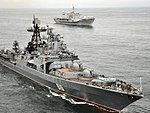Talk:National Army Naval Forces (Faneria): Difference between revisions
m (threw out old lore, moved infobox to main page. will be used for planning out list of active ships.) |
m (Kistan moved page Talk:Army Naval Bureau (Faneria) to Talk:National Army Naval Forces (Faneria)) |
Revision as of 16:02, 16 September 2022
Going into the second quarter of the century, the composition of the Army naval service is changing as older, larger warships become slightly less prominent compared to a larger force of smaller surface combatants. While the light support carrier doctrine employed by the Army remains a key point in Fhainnin strategy within the Vandarch Sea and in its littoral waters along the open ocean, budget cuts and the lack of a serious neighboring rival make lobbying for a larger navy a weak political position. Currently, the Army plans to phase out much of its older surface fleet in favor of modern designs. While the total number of heavy surface combatants will drop, a larger array of small vessels is planned. Forays into missile boats in particular are in vogue for white-water operations, though the overall trend in modern naval design is a greater integration of air assets with naval ones, as evidenced by the fact that the vast majority of new designs take landing pads into account compared to older Fhainnin designs, many of which lagged behind in this area.
Modern Fanerian battlegroup composition segregates tasks into distinct roles for each ship - primarily air defense, mine and antisubmarine warfare, surface warfare, and air support. Generally, any ship can perform multiple roles, but each specializes in a particular field and is expected to operate in that role unless circumstances require otherwise.
Ship design is typically funneled into a single production model, with a great deal of competition between design variants. The design process for lighter Fhainnin vessels also involves prototype construction and testing, and increasingly involves computer simulations as well. The army has displayed gaps in its production lines between ship classes over the years, indicating an ad-hoc design process. It is currently believed that the army is conducting panels to standardize the design process further to create some overlap and ensure regular updates to the naval service's assets.
Technologically, a majority of the fleet is second-line, or constructed between 1980 and 2010, with roughly fifteen percent of its ships being newer and another ten percent or so being constructed prior to 1980. This ageing has made for a considerable cost in maintenance and refits to keep the fleet operational. The main symptom of this was the production of smaller missile boats meant for mass production in the 1970's, bloating the fleet with over fifty light vessels in line with the posturing the navy preferred. In 2012, policy was changed to reflect a growing budget and need to maintain a technological edge rather than rely on dated equipment, demanding that naval production focus on role-dedicated destroyers and air power over the previous cruiser-centered model, along with the discontinuation of later missile boat programs and reforms in the design and planning process.
- Novara-class cruiser
- Erzherzog Karl-class battleship
- 250t-class torpedo boat
- Huszár-class destroyer
- Tátra-class destroyer
- Kaiman-class torpedo boat
- Cobra-class torpedo boat
- Russian destroyer Novik (1911)
- Ognevoy-class destroyer
- Finnish coastal defence ship Väinämöinen
- Zenta-class cruiser
- Kynda-class cruiser
- Kresta I-class cruiser
- Kresta II-class cruiser
- Sverdlov-class cruiser
- Kara-class cruiser
- Slava-class cruiser
- Kashin-class destroyer
- Udaloy-class destroyer
- Sovremenny-class destroyer
- Riga-class frigate
- Ropucha-class landing ship
- Neustrashimyy-class frigate
- Grisha-class corvette
- Moskva-class helicopter carrier
- Kiev-class aircraft carrier
- Kuznetsov-class aircraft carrier
| IRL Class | IRL Full Load Displacement | IRL Years | IC Class | IC Dimensions | IC Years | Images |
|---|---|---|---|---|---|---|
| Cobra-class torpedo boat | 135 t (133 long tons) |
|
||||
| Zenta-class cruiser | 2,503 long tons (2,543 t) |
|
||||
| Erzherzog Karl-class battleship | 10,472 long tons (10,640 t) |
|
||||
| Huszár-class destroyer | 420 t (410 long tons) |
|
||||
| Russian destroyer Novik (1911) | 1,590 long tons (1,620 t) |
|
||||
| Novara-class cruiser | 4,417 tonnes (4,347 long tons) |
|
||||
| Tátra-class destroyer | 1,050 long tons (1,070 t) |
|
||||
| 250t-class torpedo boat | 320–330 t (315–325 long tons) |
|
||||
| Kaiman-class torpedo boat | 209–211 t (206–208 long tons) |
|
||||
| Finnish coastal defence ship Väinämöinen | 3,900 t |
|
||||
| Ognevoy-class destroyer | 2,860 t (2,810 long tons) |
|
||||
| Sverdlov-class cruiser | 16,640 tonnes (16,377 long tons) |
|
||||
| Riga-class frigate | 1,416 tons |
|
||||
| Kashin-class destroyer | 4,390 tons |
|
||||
| Kynda-class cruiser | 5,500 tons |
|
||||
| Kresta I-class cruiser | 7,500 tons |
|
||||
| Kresta II-class cruiser | 7,535 tons |
|
||||
| *Grisha-class corvette | 1,070 tons |
|
||||
| Kara-class cruiser | 9,700 tons |
|
||||
| Slava-class cruiser | 11,490 tons |
|
||||
| Udaloy-class destroyer | 7,570 tons |
|
||||
| Sovremenny-class destroyer | 8,000 tons |
|
||||
| Ropucha-class landing ship |
|
|||||
| Neustrashimyy-class frigate | 4,400 tons |
|
||||
| Moskva-class helicopter carrier |
|
|||||
| Kiev-class aircraft carrier |
|
|||||
| Kuznetsov-class aircraft carrier |
|
|||||
*Draft:
|

















